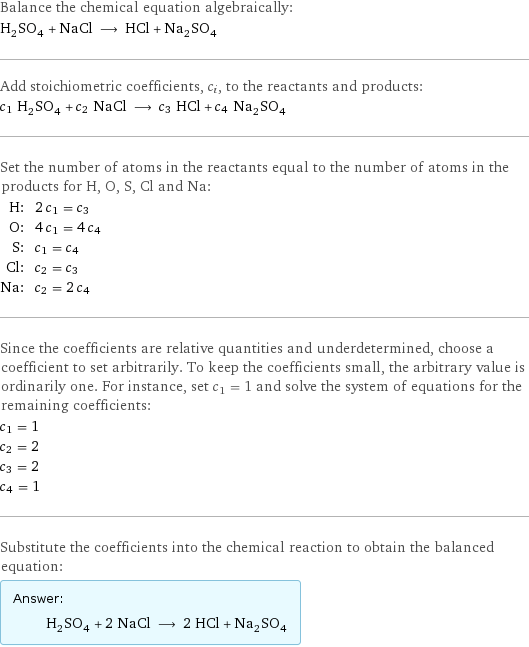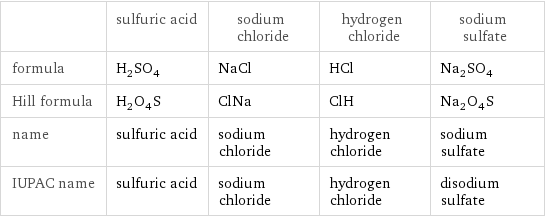Input interpretation

H_2SO_4 (sulfuric acid) + NaCl (sodium chloride) ⟶ HCl (hydrogen chloride) + Na_2SO_4 (sodium sulfate)
Balanced equation

Balance the chemical equation algebraically: H_2SO_4 + NaCl ⟶ HCl + Na_2SO_4 Add stoichiometric coefficients, c_i, to the reactants and products: c_1 H_2SO_4 + c_2 NaCl ⟶ c_3 HCl + c_4 Na_2SO_4 Set the number of atoms in the reactants equal to the number of atoms in the products for H, O, S, Cl and Na: H: | 2 c_1 = c_3 O: | 4 c_1 = 4 c_4 S: | c_1 = c_4 Cl: | c_2 = c_3 Na: | c_2 = 2 c_4 Since the coefficients are relative quantities and underdetermined, choose a coefficient to set arbitrarily. To keep the coefficients small, the arbitrary value is ordinarily one. For instance, set c_1 = 1 and solve the system of equations for the remaining coefficients: c_1 = 1 c_2 = 2 c_3 = 2 c_4 = 1 Substitute the coefficients into the chemical reaction to obtain the balanced equation: Answer: | | H_2SO_4 + 2 NaCl ⟶ 2 HCl + Na_2SO_4
Structures

+ ⟶ +
Names

sulfuric acid + sodium chloride ⟶ hydrogen chloride + sodium sulfate
Reaction thermodynamics
Enthalpy

| sulfuric acid | sodium chloride | hydrogen chloride | sodium sulfate molecular enthalpy | -814 kJ/mol | -411.2 kJ/mol | -92.3 kJ/mol | -1387 kJ/mol total enthalpy | -814 kJ/mol | -822.4 kJ/mol | -184.6 kJ/mol | -1387 kJ/mol | H_initial = -1636 kJ/mol | | H_final = -1572 kJ/mol | ΔH_rxn^0 | -1572 kJ/mol - -1636 kJ/mol = 64.7 kJ/mol (endothermic) | | |
Gibbs free energy

| sulfuric acid | sodium chloride | hydrogen chloride | sodium sulfate molecular free energy | -690 kJ/mol | -384.1 kJ/mol | -95.3 kJ/mol | -1270 kJ/mol total free energy | -690 kJ/mol | -768.2 kJ/mol | -190.6 kJ/mol | -1270 kJ/mol | G_initial = -1458 kJ/mol | | G_final = -1461 kJ/mol | ΔG_rxn^0 | -1461 kJ/mol - -1458 kJ/mol = -2.6 kJ/mol (exergonic) | | |
Equilibrium constant
![Construct the equilibrium constant, K, expression for: H_2SO_4 + NaCl ⟶ HCl + Na_2SO_4 Plan: • Balance the chemical equation. • Determine the stoichiometric numbers. • Assemble the activity expression for each chemical species. • Use the activity expressions to build the equilibrium constant expression. Write the balanced chemical equation: H_2SO_4 + 2 NaCl ⟶ 2 HCl + Na_2SO_4 Assign stoichiometric numbers, ν_i, using the stoichiometric coefficients, c_i, from the balanced chemical equation in the following manner: ν_i = -c_i for reactants and ν_i = c_i for products: chemical species | c_i | ν_i H_2SO_4 | 1 | -1 NaCl | 2 | -2 HCl | 2 | 2 Na_2SO_4 | 1 | 1 Assemble the activity expressions accounting for the state of matter and ν_i: chemical species | c_i | ν_i | activity expression H_2SO_4 | 1 | -1 | ([H2SO4])^(-1) NaCl | 2 | -2 | ([NaCl])^(-2) HCl | 2 | 2 | ([HCl])^2 Na_2SO_4 | 1 | 1 | [Na2SO4] The equilibrium constant symbol in the concentration basis is: K_c Mulitply the activity expressions to arrive at the K_c expression: Answer: | | K_c = ([H2SO4])^(-1) ([NaCl])^(-2) ([HCl])^2 [Na2SO4] = (([HCl])^2 [Na2SO4])/([H2SO4] ([NaCl])^2)](../image_source/87c6d654da689ee1b7c286293d088bed.png)
Construct the equilibrium constant, K, expression for: H_2SO_4 + NaCl ⟶ HCl + Na_2SO_4 Plan: • Balance the chemical equation. • Determine the stoichiometric numbers. • Assemble the activity expression for each chemical species. • Use the activity expressions to build the equilibrium constant expression. Write the balanced chemical equation: H_2SO_4 + 2 NaCl ⟶ 2 HCl + Na_2SO_4 Assign stoichiometric numbers, ν_i, using the stoichiometric coefficients, c_i, from the balanced chemical equation in the following manner: ν_i = -c_i for reactants and ν_i = c_i for products: chemical species | c_i | ν_i H_2SO_4 | 1 | -1 NaCl | 2 | -2 HCl | 2 | 2 Na_2SO_4 | 1 | 1 Assemble the activity expressions accounting for the state of matter and ν_i: chemical species | c_i | ν_i | activity expression H_2SO_4 | 1 | -1 | ([H2SO4])^(-1) NaCl | 2 | -2 | ([NaCl])^(-2) HCl | 2 | 2 | ([HCl])^2 Na_2SO_4 | 1 | 1 | [Na2SO4] The equilibrium constant symbol in the concentration basis is: K_c Mulitply the activity expressions to arrive at the K_c expression: Answer: | | K_c = ([H2SO4])^(-1) ([NaCl])^(-2) ([HCl])^2 [Na2SO4] = (([HCl])^2 [Na2SO4])/([H2SO4] ([NaCl])^2)
Rate of reaction
![Construct the rate of reaction expression for: H_2SO_4 + NaCl ⟶ HCl + Na_2SO_4 Plan: • Balance the chemical equation. • Determine the stoichiometric numbers. • Assemble the rate term for each chemical species. • Write the rate of reaction expression. Write the balanced chemical equation: H_2SO_4 + 2 NaCl ⟶ 2 HCl + Na_2SO_4 Assign stoichiometric numbers, ν_i, using the stoichiometric coefficients, c_i, from the balanced chemical equation in the following manner: ν_i = -c_i for reactants and ν_i = c_i for products: chemical species | c_i | ν_i H_2SO_4 | 1 | -1 NaCl | 2 | -2 HCl | 2 | 2 Na_2SO_4 | 1 | 1 The rate term for each chemical species, B_i, is 1/ν_i(Δ[B_i])/(Δt) where [B_i] is the amount concentration and t is time: chemical species | c_i | ν_i | rate term H_2SO_4 | 1 | -1 | -(Δ[H2SO4])/(Δt) NaCl | 2 | -2 | -1/2 (Δ[NaCl])/(Δt) HCl | 2 | 2 | 1/2 (Δ[HCl])/(Δt) Na_2SO_4 | 1 | 1 | (Δ[Na2SO4])/(Δt) (for infinitesimal rate of change, replace Δ with d) Set the rate terms equal to each other to arrive at the rate expression: Answer: | | rate = -(Δ[H2SO4])/(Δt) = -1/2 (Δ[NaCl])/(Δt) = 1/2 (Δ[HCl])/(Δt) = (Δ[Na2SO4])/(Δt) (assuming constant volume and no accumulation of intermediates or side products)](../image_source/eece11489faa9cb2853a27dd18861883.png)
Construct the rate of reaction expression for: H_2SO_4 + NaCl ⟶ HCl + Na_2SO_4 Plan: • Balance the chemical equation. • Determine the stoichiometric numbers. • Assemble the rate term for each chemical species. • Write the rate of reaction expression. Write the balanced chemical equation: H_2SO_4 + 2 NaCl ⟶ 2 HCl + Na_2SO_4 Assign stoichiometric numbers, ν_i, using the stoichiometric coefficients, c_i, from the balanced chemical equation in the following manner: ν_i = -c_i for reactants and ν_i = c_i for products: chemical species | c_i | ν_i H_2SO_4 | 1 | -1 NaCl | 2 | -2 HCl | 2 | 2 Na_2SO_4 | 1 | 1 The rate term for each chemical species, B_i, is 1/ν_i(Δ[B_i])/(Δt) where [B_i] is the amount concentration and t is time: chemical species | c_i | ν_i | rate term H_2SO_4 | 1 | -1 | -(Δ[H2SO4])/(Δt) NaCl | 2 | -2 | -1/2 (Δ[NaCl])/(Δt) HCl | 2 | 2 | 1/2 (Δ[HCl])/(Δt) Na_2SO_4 | 1 | 1 | (Δ[Na2SO4])/(Δt) (for infinitesimal rate of change, replace Δ with d) Set the rate terms equal to each other to arrive at the rate expression: Answer: | | rate = -(Δ[H2SO4])/(Δt) = -1/2 (Δ[NaCl])/(Δt) = 1/2 (Δ[HCl])/(Δt) = (Δ[Na2SO4])/(Δt) (assuming constant volume and no accumulation of intermediates or side products)
Chemical names and formulas

| sulfuric acid | sodium chloride | hydrogen chloride | sodium sulfate formula | H_2SO_4 | NaCl | HCl | Na_2SO_4 Hill formula | H_2O_4S | ClNa | ClH | Na_2O_4S name | sulfuric acid | sodium chloride | hydrogen chloride | sodium sulfate IUPAC name | sulfuric acid | sodium chloride | hydrogen chloride | disodium sulfate
Substance properties

| sulfuric acid | sodium chloride | hydrogen chloride | sodium sulfate molar mass | 98.07 g/mol | 58.44 g/mol | 36.46 g/mol | 142.04 g/mol phase | liquid (at STP) | solid (at STP) | gas (at STP) | solid (at STP) melting point | 10.371 °C | 801 °C | -114.17 °C | 884 °C boiling point | 279.6 °C | 1413 °C | -85 °C | 1429 °C density | 1.8305 g/cm^3 | 2.16 g/cm^3 | 0.00149 g/cm^3 (at 25 °C) | 2.68 g/cm^3 solubility in water | very soluble | soluble | miscible | soluble surface tension | 0.0735 N/m | | | dynamic viscosity | 0.021 Pa s (at 25 °C) | | | odor | odorless | odorless | |
Units
